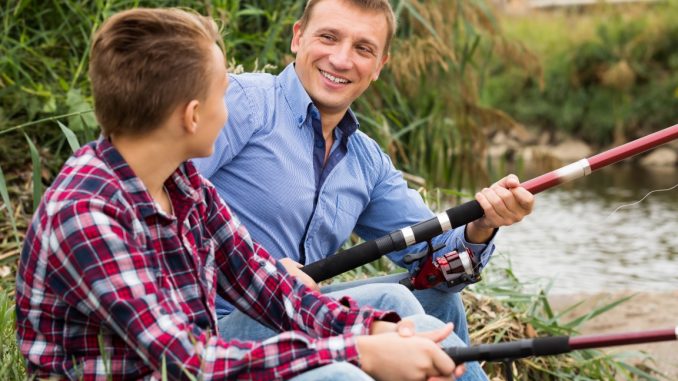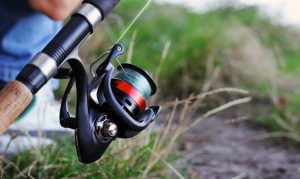
All fishing rods are not equal, so find out how to choose the right fishing rod for the fish you hunt and the water you frequent.
Fishing rods are made of four basic parts. It is the sum of those parts that create the perfect fishing rod. Easy as that sounds, the concept is highly subjective. For example, the type of rod for northern pike fishing is quite different from the rod you select to fish for bass. Yet, to fish both, you need the right rod. Let’s explore.
Fishing Rod Parts
The parts that make up all modern fishing rods include:
- Blanks: The blanks are the sections that make up the basic rod. They come in carbon fiber or graphite. Fishing rods use one blank or four or more blanks.
- Guides: Guides are the eyes that “guide” the fishing line from the reel to the tip of the rod. They are a critical component to fishing rod construction.
- Handle/grip: The handle and grips are where your hands rest on the rod. Grips need to be comfortable while fishing, casting and battling fish. Grip matters as much as comfort.
- Reel seats: Reel seats are what hold or fasten the reel to the blanks. A poorly constructed rod seat will not only ruin your day of fishing but will likely ruin your rod as well.
In short, the components that go into a complete fishing rod are important. What do you need to know about them to pick the perfect rod?
Let’s look a little deeper.
The Fish and Fishing Rods
 When you choose a fishing rod, you do so with the fish in mind. Fish react differently due to many factors. That is exactly why picking the perfect rod is tricky. We look at the average fish weight for a species, how the fish bites and how it battles. Those aspects create the “needs” that make up a perfect fishing rod.
When you choose a fishing rod, you do so with the fish in mind. Fish react differently due to many factors. That is exactly why picking the perfect rod is tricky. We look at the average fish weight for a species, how the fish bites and how it battles. Those aspects create the “needs” that make up a perfect fishing rod.
The language that describes fishing rods is often confusing. Here is a helpful list of terms and what they mean:
- Power or rod weight: Refers specifically to the stiffness of the blanks. The word “power” is best thought of as the amount of power needed to bend the rod. If you hold a rod horizontal and you tied a line with a weight on it to the end, how much weight would you add before the rod bends?
Rule of thumb: The stiffer the rod, the less you feel. It is more difficult to feel a bite or your lure or sinker roll along the bottom with a heavier rod.
- Action: A rod’s action is a complement of its power or weight. The action of a rod is a measurement of the degree in which the rod bends, given the weight or its power. A flexible rod is a slow action rod. A rod that takes a lot of weight or power to bend has fast action. Action is also measured by the spots along the rod that bend. A fast action rod will only bend toward the tip of the rod, whereas, a slow action rod is likely to bend from the tip to nearly the reel seat.
Rule of thumb: Slower the action the smaller the fish that a rod will handle. A trophy largemouth bass may weigh in at about 8 pounds. A trophy northern pike is likely to crest the 40-pound mark. The difference in both the action and the power of fishing rods between these two fish is drastic.
How to Choose the Right Fishing Rod
 Think about the fish you plan to target — weight, striking tendencies, etc.
Think about the fish you plan to target — weight, striking tendencies, etc.
- Muskie and northern pike: Big fish means big strikes. Use a 7-foot to 9-foot rod with medium/heavy action.
- Walleye: Use a 7-foot to 9-foot rod, with light/medium to medium/heavy action for live bait; or an 8-foot to 10-foot rod with medium/heavy weight for trolling.
- Smallmouth bass: A 7-foot to 9-foot rod is ideal in length in medium to medium/heavy weight.
- Lake trout: Use a 7-foot to 9-foot rod with medium/heavy to heavy action.
When you choose a fishing rod, consider your own height. As a general rule of thumb: If you are shorter than 6 feet, shorter rods work better; and if you are taller than 6 feet, long rods work better.
How you fish is also key: Jigging rods are usually shorter in the 5-foot-5-inch to 6-foot-5-inch range. Trolling rods are typically longer with a heavier action. Casting rods are often right in the middle for both length and weight. This short guide should make choosing the right rod much easier and improve your fishing experience.
Author bio: Dave and Sheree Swistun are owners of Duck Bay Lodge, a fishing resort located in Lake of the Woods, Ontario, Canada. Built more than 60 years ago, they are the fourth owners, having purchased Duck Bay Lodge in 1988.
